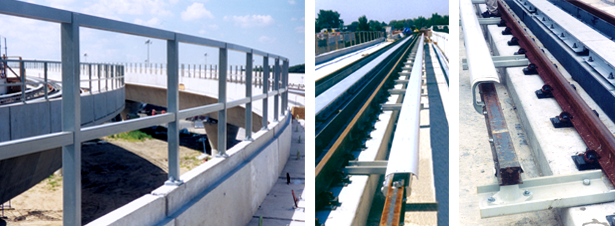Case Study: Rail System Requires Miles of Fiberglass
 Strongwell fiberglass products played an integral role in the construction of an eight-mile, $1.5 billion commuter rail system that will connect New York City’s existing transit systems with JFK International Airport.
Strongwell fiberglass products played an integral role in the construction of an eight-mile, $1.5 billion commuter rail system that will connect New York City’s existing transit systems with JFK International Airport.
Strongwell fiberglass third rail protection boards, tie extender brackets, SAFRAIL™ handrail and DURAGRID® T-5000 2” pultruded grating are being installed along a new elevated light rail system, dubbed AirTrain.
Approximately 100,000 feet of fiberglass protection board has been installed to cover the top of the railway’s electric third rail. A collector arm extends from the train and connects to the third rail, providing power to the train. The protection board guards against stray current, insulates workers from the “live” rail and shields the rail from material dropped from trains and overpasses. 12,000 tie extender brackets were also installed to support the rail, molded brackets, and protection board.
Along with the protection board and tie extender brackets, more than 31,000 linear feet of SAFRAIL™ handrail and 700,000 square feet of DURAGRID® grating were installed along the tracks to create a safe walkway for maintenance workers and emergency egress for passengers.
| TECHNICAL DATA |
|---|
| Products: Third Rail Protection Boards, Tie Extender Brackets, Grating and Handrail |
| Process: Pultrusion |
| Materials: Fiberglass custom shapes SAFRAIL™ handrail DURAGRID® T-5000 2" grating, gray |
Sizes: Collector Arm:
Third Rail Protection Board:
Handrail:
|
| For: Atlantic Track and Turnout Co. |
Bill Roan, project coordinator for Strongwell partner Atlantic Track and Turnout Co., said that fiberglass products were chosen for the projects because of ease of installation, durability, longterm cost efficiency and non-conductivity. “The non-conductivity of fiberglass is essential in a project such as this. The AirRail Transit Consortium came to us and specified that all products going into the line needed to be nonmetallic,” said Roan.
Engineers in Bristol worked with the AirRail Transit Consortium to custom design tie extender brackets that would be strong enough to meet the project’s specifications.